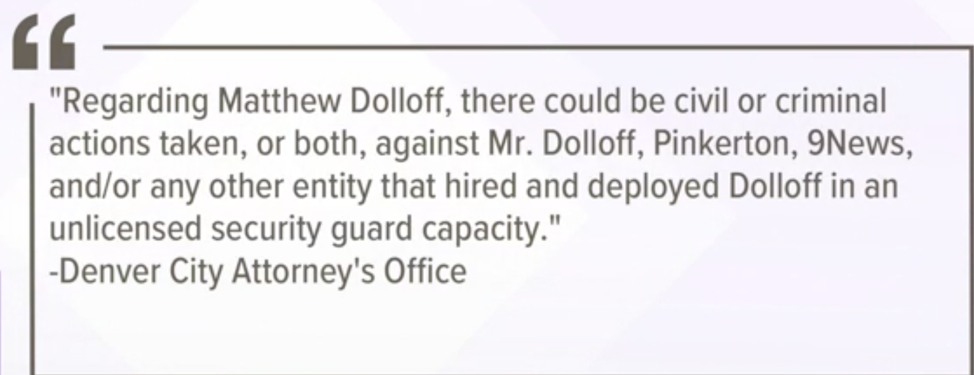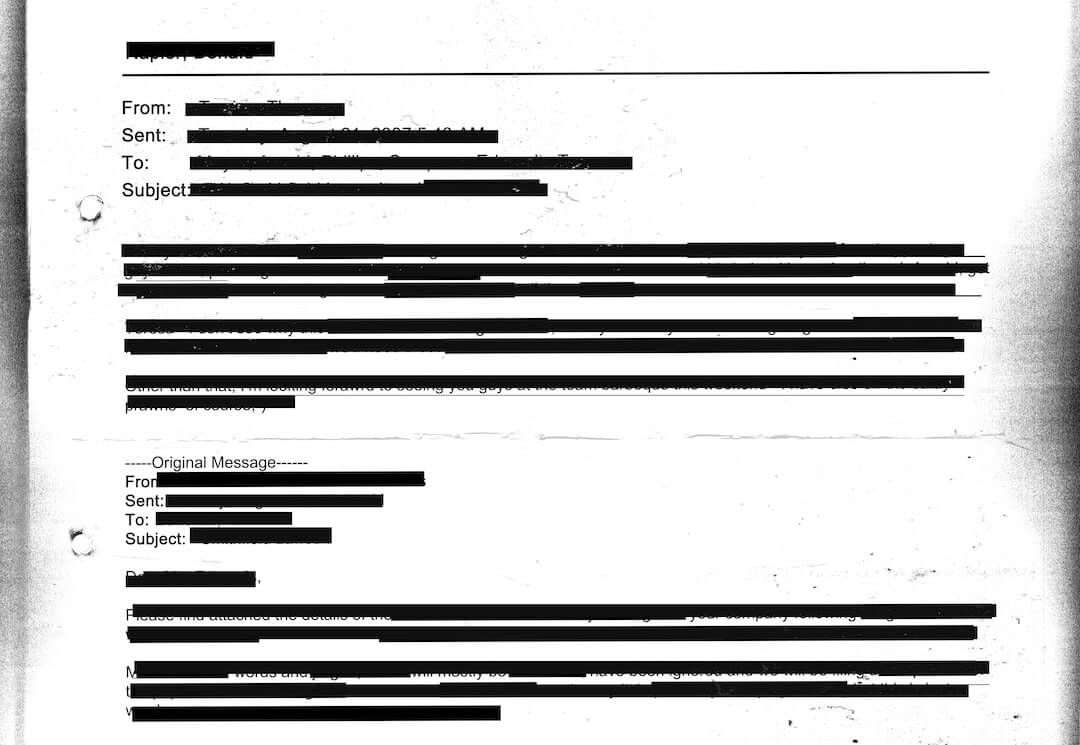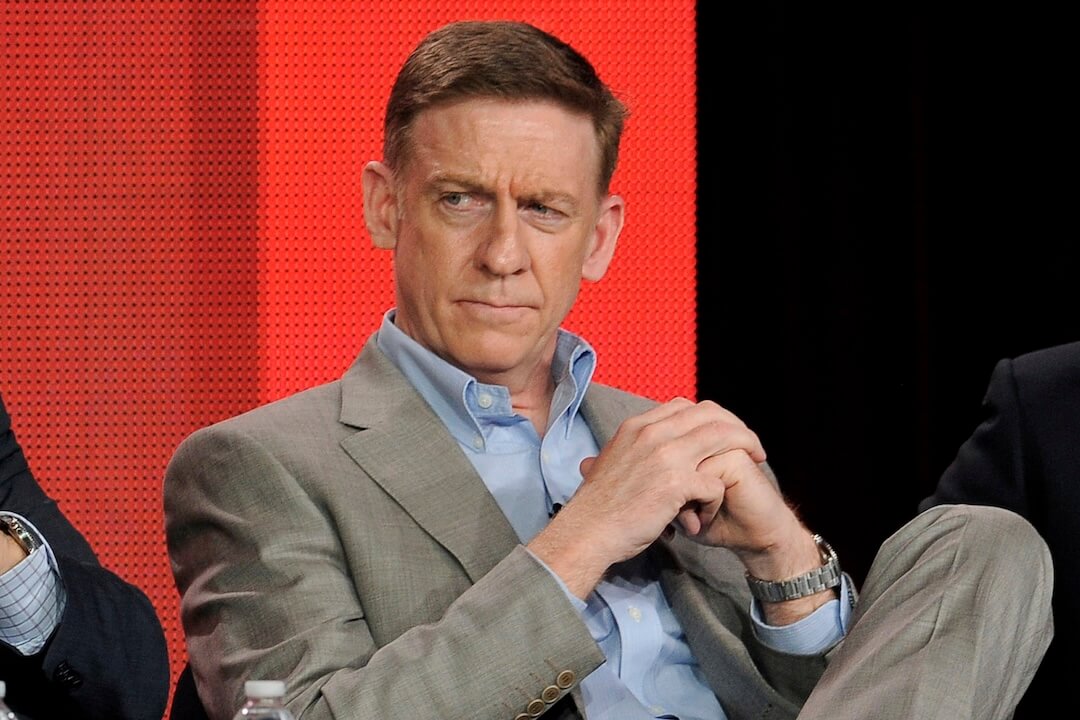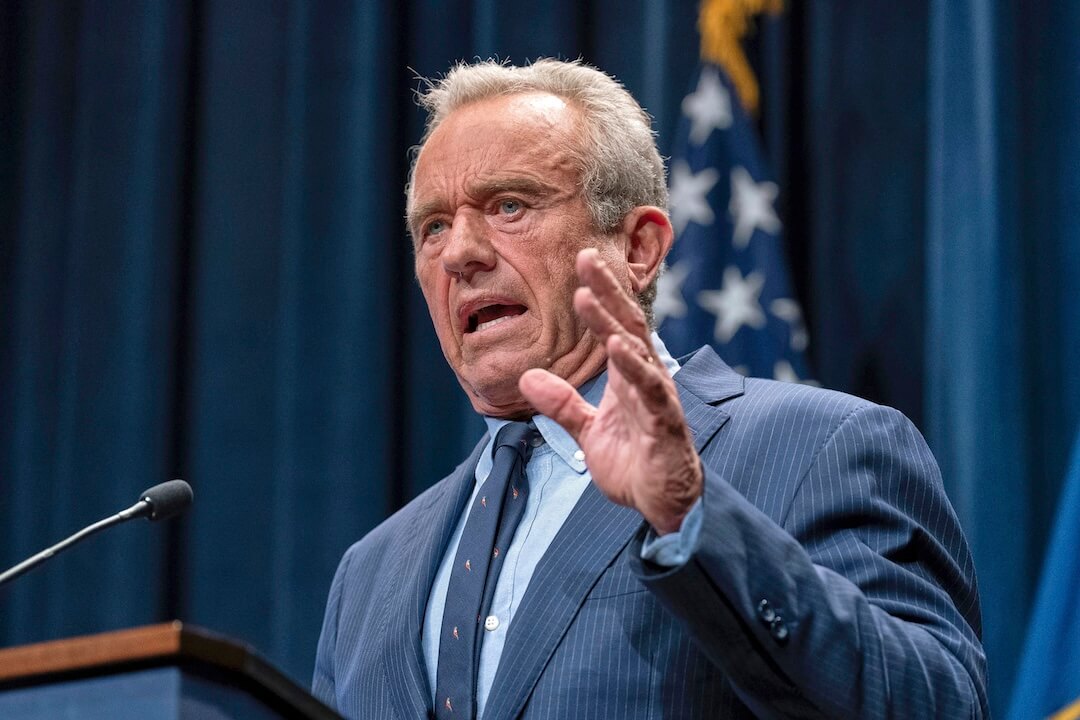KUSA-TV in Denver said it thought it hired a guard from the Pinkerton security company. But Pinkerton said the guard, who did not have a license, was subcontracted from another company. That guard, Matthew Dolloff, shot and killed a demonstrator named Lee Keltner on Saturday.
News photos from the moment of the shooting show the victim spraying a can of mace toward Dolloff, who has a drawn pistol in his hands.
Dolloff is now in jail and could face murder charges. A judge has sealed all of the records in the case, so additional security camera video that might have captured the incident is still under wraps.
Tegna-owned KUSA, branded locally as 9NEWS, has produced several stories on the shooting, including one from its investigative unit. On Monday night, the station led its newscast with a report on the shooting and explained how it was turning to Tegna journalists from other cities to independently investigate the story.
“9NEWS covers many different kinds of stories, but it is rare that the television station is directly involved in them,” an editor’s note at the top of the station’s coverage reads. “Because of that, 9NEWS brought in reporter Jason Whitely from our sister station WFAA in Dallas to cover the initial stages of the shooting and investigation.”
The reporting Monday night included a statement from the Denver city attorney’s office that said the station, as well as the unlicensed security guard and the company that supplied him to KUSA, could have a lot of legal problems ahead:

(KUSA-TV)
9NEWS general manager Mark Cornetta released a statement about the incident that said, “9NEWS is deeply saddened by this loss of life. We have and will continue to cooperate fully with law enforcement.”
While police and prosecutors explore what happened and what criminal charges might result, journalists tell Poynter that from networks to local stations, it has become common practice to send security officers with news crews, and that it is not at all uncommon in some TV markets for those guards to be armed.
You can see why in this chart from the U.S. Press Freedom Tracker:
Latest reported aggressions against the press as of Oct. 8, 2020
*856+ total press freedom incidents*
118+ arrests
215 physical attacks (153 by law enforcement)
196 rubber bullet / projectiles
99 tear gassings
63 pepper sprayings
90 equipment/newsroom damage
75 other/TBD— U.S. Press Freedom Tracker (@uspresstracker) October 8, 2020
Keep in mind the chart focuses mostly on attacks by police. Add to that the hundreds of assaults from demonstrators.
Cameras attract trouble and troublemakers. Veteran journalists I spoke with told me they feel they need security to travel with them because journalists are under attack from all sides.
KUSA reported that it “has been the practice of 9NEWS for a number of months to contract private security to accompany staff at protests.”
In San Francisco, KPIX-TV reported that since 2011, when news crews covered the Occupy Wall Street protests, “dozens of journalists have been beaten, mugged, held at gunpoint or pistol-whipped.” Just this year, on Aug. 10, a security camera captured a man with a pistol robbing a photojournalist.
[the_ad id=”667826″]
KPIX’s Joe Vazquez has been a reporter for nearly 35 years and said a few years ago, a “jarring increase” in Bay Area TV crews being robbed at gunpoint prompted stations there to routinely travel with armed security.
In February 2019, Vazquez, photographer John Anglin and a security guard were parked in front of a library at 5 p.m. waiting for an interviewee to arrive when two men pulled up.
“One guy pointed a gun at our photographer and said, ‘I need that camera.’ The other guy shot our guard in the leg,” Vazquez said. “While the guard was lying bleeding, the robber came back and pointed the gun again. The guard, who was a 20-year veteran and trainer at the Berkeley Police Department, took out his phone and handed it to the guy and said, ‘Here, this is all I have, take it.’ With his other hand, the guard reached for his gun and fired.”
The two robbers took off. Police caught up with them 20 minutes later when one of them showed up at a hospital with gunshot wounds.
When San Francisco TV stations began routinely sending guards with crews, veteran journalists resisted.
“It was a little bit of adjustment,” Vazquez said. “When we go somewhere, we want to show we are not affiliated with any organization, not with the police or anybody.”
But, he said, security guards have been key to avoiding confrontation.
“We started to learn that our security guards, most of them retired, experienced police officers, draw an imaginary perimeter around us and confront anyone who breaches that perimeter,” Vazquez said. “These are experienced officers, they are the ones who are steeped in de-escalation. We don’t know how many times they picked off an attack. Sometimes they say ‘it is time to go’ and we go. Maybe they see somebody drive by more than once.”
Vazquez said the guards have changed the way reporters approach some stories.
“What we have decided is we are going to approach every single situation differently,” he said. “When we go out on an assignment, we have a little meeting with the guard and agree that if we get in the thick of it that we immediately move out of the thick of it. Maybe we go in with our cellphone cameras to keep a low profile.”
[the_ad id=”667872″]
Lynn French spent 24 years as a photojournalist in Raleigh and Phoenix. She is tough, and played roller derby in her off time.
“The anger toward journalists is higher than ever,” said French, who now is an adjunct professor at the Arizona State University Walter Cronkite School of Journalism and Mass Communications. “If they see you are from a TV station, newspaper, even just presenting yourself on behalf of a blog, people feel the need to push you to take a side. They are looking for a fight. They want to draw out your opinions so they can pick that fight with you. Or they want to know you are suddenly on their side.”
In her days as a photojournalist, French said, she sometimes traveled with a security guard but could not recall ever asking if they were armed.
“I feel like it would just escalate the emotional temperature of the situation if emotions are running high,” she said. “In Arizona, lots of people show up to these protests with guns. If the journalist is protected by somebody with a gun that could send a political message. And if the situation gets out of hand, triggers could get pulled.”
Chris Post, chair of the National Press Photographers Association’s Safety and Security Committee, brings 20 years of public safety experience to his decade of working as a photographer. He was an EMT and firefighter before he was a journalist.
Post said he understands why journalists, especially his fellow TV photojournalists, feel they need security, but he said their most important role is in what he calls “verbal de-escalation.”
“There is a belief structure that has been created over several years,” Post said, “where the media is the enemy.”
Mickey Osterreicher, an experienced photojournalist and NPPA’s general counsel, told me he first encountered armed security traveling with journalists during the 2012 NATO summit protests in Chicago.
“I think this is more of a decision by news organizations than by journalists,” Osterreicher said. “It may be a decision made to protect the organization from liability (or even an insurance requirement) as much as to protect the journalists themselves. It may or may not be something those journalists agree with but as employees or contracted freelancers they must follow.
“The bigger question,” he said, “is what training and qualifications those guards have and if they are hired directly by the news organization or through a security firm. Another issue to be examined is the use of force and self-defense statutes in each state as well as the licensing requirements to be able to carry a firearm (open or concealed).”
[the_ad id=”667878″]
In San Francisco, newsrooms take crew safety so seriously that the two unions that represent reporters and photojournalists — the Screen Actors Guild-American Federation of Television and Radio Artists and the National Association of Broadcast Employees and Technicians — organize regular meetings that news directors and sometimes even upper station management from all of the stations attend to discuss security matters.
Vazquez is a SAG-AFTRA shop steward at KPIX and said the meetings are “a collective effort by the stations that would never cooperate on anything else, but they do on this. It is common for somebody to send out an alert email to all of the stations and union leaders when there is something we all need to know to protect ourselves and our equipment.”
He said in addition to sending security with crews fairly routinely, TV newsroom managers have adapted to the dangers of working in the field.
“Today, management must give some autonomy to the crews,” Vazquez said. “This has been a moment where our management has come around to the idea of ‘if you have to make a decision to be safe, then make that decision, don’t call in, get out of there first, then call in.’ That is different in a business that used to be so top-down.”







